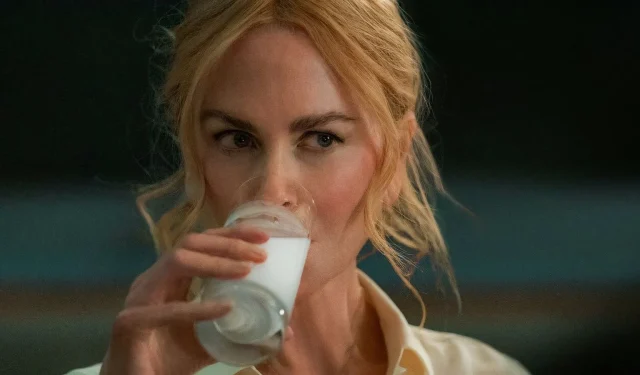
Insight from Halina Reijn on Babygirl’s Provocative Milk Scene
Halina Reijn, the director behind the erotic thriller Babygirl, has shared her inspirations for a notable scene involving milk, which profoundly explores themes of power and awakening. Following her previous work on the satirical horror film Bodies Bodies Bodies, Reijn’s latest project navigates complex dynamics between a high-powered CEO, Romy (played by Nicole Kidman), and her younger intern, Samuel (Harris Dickinson). The film also features performances from Antonio Banderas and Sophie Wilde, deepening the narrative of Romy’s journey toward self-discovery.
The Intimate Milk Scene: A Personal Encounter
In a revealing interview with IndieWire, Reijn discussed a personal experience that informed this intimate moment in Babygirl. At a company holiday party in a dimly lit bar, Romy becomes intrigued by Samuel when he unexpectedly sends her a glass of milk. This simple gesture sparks a complex psychological exchange between them, marked by themes of submission and dominance. Reijn reflects on the scene’s implications:
The milk is, of course, an archetype. We’ve seen it in other movies. It is a great symbol of animalistic sides of ourselves. It happened to me. I was playing in Belgium onstage, and I got offstage, and I had a really good run, and I was like, ‘Oh my god!’ I felt really good about myself for one night in my life. All my colleagues were like, ‘No, we’re going to bed.’ They’re all boring. I was all alone.
I went to a bar, and I ordered something boring like a Diet Coke because I didn’t drink at that time because I was a control freak. There was this young Belgian actor — I can’t say who it is — but he was famous. I knew of him. I’d never spoken to him. He was at least 15 years younger than I, and he ordered me a glass of milk.
I thought it was an incredible, hot thing to do, and so courageous, and so I wanted to reward him by drinking the whole thing, and I did. It did make me a little nauseated, to be honest with you, because it was cow milk. It was back in the day.
Exploring the Psychology of Intimacy
While the actor did not whisper a seductive farewell, Reijn emphasizes the profound psychological aspects of arousal that can emerge without physical intimacy. She offers insight into what captivates her about sexuality:
I wish he did. He just walked out. I didn’t have sex with him or anything. But when I was writing, I did think that was one of the most arousing moments of my life. There wasn’t even touching. That is what fascinates me about sex. To me, real, shocking sex is often not at all two bodies banging into each other. To me, real, shocking sex is about what is in the mind. It’s all suggestion. It’s all imagination. [Romy] crawling around on a dirty carpet with stains and licking a little bit of candy out of his hand, and him petting her like she’s an animal — that, to me, is really sexy. Real sex acts to me onscreen are quite boring, which is why we only have two short moments of that.
Symbolism Behind the Milk Scene
The milk scene in Babygirl serves as a metaphorical vessel filled with unexpected meanings. It crystallizes the evolving relationship between Romy and Samuel, complicated by their age difference and professional dynamics. Traditionally seen as a representation of innocence and purity, the glass of milk takes on a more subversive connotation within the context of their non-verbal communication, encapsulating the tension of their hidden desires.
A Shift Toward Psychological Tension
Reijn’s directorial choice to prioritize cerebral eroticism over explicit visual displays aligns with a modern cinematic trend. Similar approaches can be seen in recent works like Luca Guadagnino’s Challengers (2024) and Paul Thomas Anderson’s Phantom Thread (2017). In these narratives, the moments of sexual tension and character exploration often overshadow traditional portrayals of physical intimacy.
Final Thoughts on the Milk Scene
In Babygirl, Halina Reijn artfully crafts a narrative where a simple glass of milk evolves into a crucial moment of seduction and self-discovery. Kidman’s portrayal of Romy captures the delicate balance of vulnerability and strength, illuminating a woman’s journey to reclaim her desires within the complexities of relationships.
As the film navigates themes of power dynamics relating to gender and age, it contributes significantly to contemporary discussions surrounding desire. The transformation of a mundane object into a compelling narrative element exemplifies how sometimes, the simplest symbols can evoke profound transformations.
Source: IndieWire




Leave a Reply